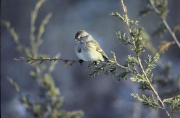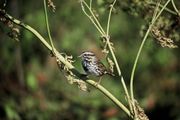Difference between revisions of "Sparrow"
Jump to navigation
Jump to search
(username removed) |
|||
| (3 intermediate revisions by 2 users not shown) | |||
| Line 1: | Line 1: | ||
[[File:American tree sparrow.jpg|thumb|American tree sparrow ''Spizella arborea'']] | [[File:American tree sparrow.jpg|thumb|American tree sparrow ''Spizella arborea'']] | ||
== Description == | == Description == | ||
| − | |||
| − | |||
| − | |||
[[File:White-crowned sparrow.jpg|thumb|White-crowned sparrow, ''Zonotrichia leucophrys'']] | [[File:White-crowned sparrow.jpg|thumb|White-crowned sparrow, ''Zonotrichia leucophrys'']] | ||
| + | Small, seed-eating [[bird|birds]] (families Passeridae and Fringillidae) that are commonly found in North America, Europe, and Australia. The English sparrow (Passer domesticus) was introduced to North America (Brooklyn) in 1852 and has since spread throughout the continent. Also called the house sparrow, it likes to nest in house eaves and masonry holes. Sparrows can be aggresive and often produce significant debris and deleterious droppings (see [[guano|guano]]). Numerous [[deterrent|deterrent]] methods used for larger birds, such as nets, spikes, wires, gels, plastic owls, electric shocks, along with many types of mechanical and ultrasonic devices are being used with moderate success. | ||
| + | [[File:Song Sparrow.jpg|thumb|Song Sparrow, ''Melospiza melodia'']] | ||
== Synonyms and Related Terms == | == Synonyms and Related Terms == | ||
English sparrow (Passer domesticus); house sparrow | English sparrow (Passer domesticus); house sparrow | ||
| − | == | + | ==Resources and Citations== |
| − | |||
| − | |||
| − | |||
| − | |||
| − | |||
| − | |||
| − | |||
| − | * ''Encyclopedia Britannica'', http://www.britannica.com Comment: "house sparrow." | + | * ''Encyclopedia Britannica'', http://www.britannica.com Comment: "house sparrow." Accessed 17 Mar. 2005. |
| − | * Wikipedia | + | * Wikipedia: http://en.wikipedia.org/wiki/Sparrow |
[[Category:Materials database]] | [[Category:Materials database]] | ||
Latest revision as of 15:34, 2 June 2022
Description
Small, seed-eating birds (families Passeridae and Fringillidae) that are commonly found in North America, Europe, and Australia. The English sparrow (Passer domesticus) was introduced to North America (Brooklyn) in 1852 and has since spread throughout the continent. Also called the house sparrow, it likes to nest in house eaves and masonry holes. Sparrows can be aggresive and often produce significant debris and deleterious droppings (see Guano). Numerous Deterrent methods used for larger birds, such as nets, spikes, wires, gels, plastic owls, electric shocks, along with many types of mechanical and ultrasonic devices are being used with moderate success.
Synonyms and Related Terms
English sparrow (Passer domesticus); house sparrow
Resources and Citations
- Encyclopedia Britannica, http://www.britannica.com Comment: "house sparrow." Accessed 17 Mar. 2005.
- Wikipedia: http://en.wikipedia.org/wiki/Sparrow


